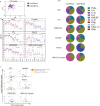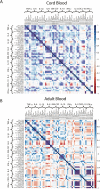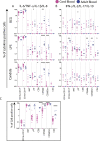Immune profiling reveals umbilical cord blood mononuclear cells from South India display an IL-8 dominant, CXCL-10 deficient polyfunctional monocyte response to pathogen-associated molecular patterns that is distinct from adult blood cells
- PMID: 38695079
- PMCID: PMC11310697
- DOI: 10.1093/cei/uxae034
Immune profiling reveals umbilical cord blood mononuclear cells from South India display an IL-8 dominant, CXCL-10 deficient polyfunctional monocyte response to pathogen-associated molecular patterns that is distinct from adult blood cells
Abstract
Neonate responses to pathogen-associated molecular patterns (PAMPS) differ from adults; such understanding is poor in Indian neonates, despite recognized significant infectious risk. Immune profiling analysis was undertaken of 10 secreted mediators contextualized with cellular source induced by six PAMPs in umbilical cord (CB; n = 21) and adult-blood (PBMC; n = 14) from a tertiary care hospital in South India. Differential cytokine expression analysis (minimum log2-fold difference; adj P-value < 0.05) identified bacterial PAMPs induced higher concentrations of IL-1β, IL-10, TNF-α in adults versus IL-8, GM-CSF, IFN-γ, and IL-2 in CB. CB responded to poly I:C and SARS-CoV-2 lysate with a dominant IL-8 response, whereas in PBMC, CXCL-10 dominated poly I:C, but not SARS-CoV-2, responses, highlighting potential IL-8 importance, in the absence of Type I Interferons, in antiviral CB immunity. Candida albicans was the only PAMP to uniformly induce higher secretion of effectors in CB. The predominant source of IL-8/IL-6/TNF-α/IL-1β in both CB and PBMC was polyfunctional monocytes and IFN-γ/IL-2/IL-17 from innate lymphocytes. Correlation matrix analyses revealed IL-8 to be the most differentially regulated, correlating positively in CB versus negatively in PBMC with IL-6, GM-CSF, IFN-γ, IL-2, consistent with more negatively regulated cytokine modules in adults, potentially linked to higher anti-inflammatory IL-10. Cord and adult blood from India respond robustly to PAMPs with unique effector combinations. These data provide a strong foundation to monitor, explore, mechanisms that regulate such immunity during the life course, an area of significant global health importance given infection-related infant mortality incidence.
Keywords: cytokines; monocytes; neonates; pathogen-associated molecular patterns; toll-like receptors.
© The Author(s) 2024. Published by Oxford University Press on behalf of the British Society for Immunology.
Conflict of interest statement
The authors declare that the research was conducted in the absence of any commercial or financial relationships that could be construed as a potential conflict of interest.
Figures







Similar articles
-
Candida albicans and Candida krusei differentially induce human blood mononuclear cell interleukin-12 and gamma interferon production.Infect Immun. 2000 May;68(5):2464-9. doi: 10.1128/IAI.68.5.2464-2469.2000. Infect Immun. 2000. PMID: 10768932 Free PMC article.
-
Intracellular cytokine profile of cord blood T-, and NK- cells and monocytes.Haematologica. 2000 Jul;85(7):675-9. Haematologica. 2000. PMID: 10897117
-
Early immune profiling reveals distinct inflammatory responses between children and adults few days after primary SARS-CoV-2 infection.Front Immunol. 2024 Nov 18;15:1359993. doi: 10.3389/fimmu.2024.1359993. eCollection 2024. Front Immunol. 2024. PMID: 39624095 Free PMC article.
-
Genetic and Epigenetic Regulation of the Innate Immune Response to Gout.Immunol Invest. 2023 Apr;52(3):364-397. doi: 10.1080/08820139.2023.2168554. Epub 2023 Feb 6. Immunol Invest. 2023. PMID: 36745138 Review.
-
The regulation and biological activity of interleukin 12.Leuk Lymphoma. 1998 May;29(5-6):427-38. doi: 10.3109/10428199809050903. Leuk Lymphoma. 1998. PMID: 9643557 Review.
References
-
- UNICEF. Child survival: under-five mortality. UNICEF Data. https://data.unicef.org/topic/child-survival/under-five-mortality/
-
- UNICEF. The state of the world’s children 2023: statistical tables. . UNICEF Data. https://data.unicef.org/resources/dataset/the-state-of-the-worlds-childr...
-
- Ministry of Health and Family Welfare. (2021). NFHS-5 phase-II. Retrieved from https://main.mohfw.gov.in/sites/default/files/NFHS-5_Phase-II_0.pdf
-
- Sample Registration System. Report (2015-17). National Health Mission, Ministry of Health and Family Welfare, Government of India. https://nhm.gov.in/index1.php?lang=1&level=2&sublinkid=819&lid=219
MeSH terms
Substances
Grants and funding
- UM1 AI 068618/National Institute of Allergy and Infectious Diseases of the US National Institutes of Health
- BT/COVID0073/02/20/DBT-Biotechnology Industry Research Assistance Council
- Felicity Wilde Charitable Trust
- BT/PR30219/MED/15/189/2018/Department of Biotechnology, Ministry of Science and Technology, India (DBT)
- DBT-National Institutes of Health (NIH)
LinkOut - more resources
Full Text Sources
Medical
Miscellaneous

